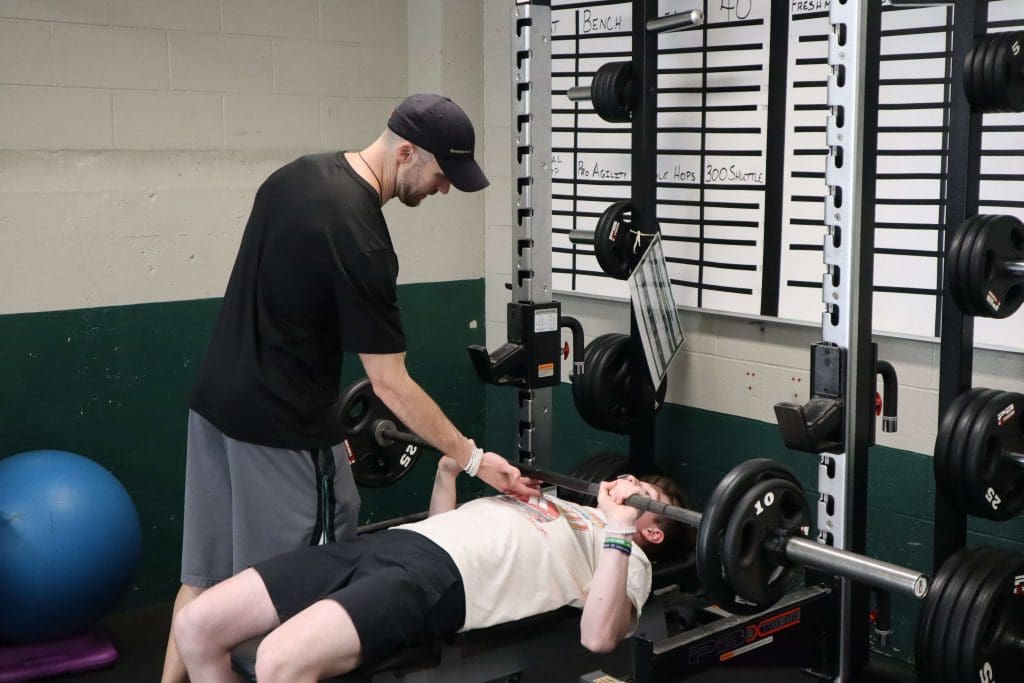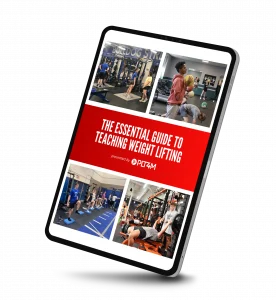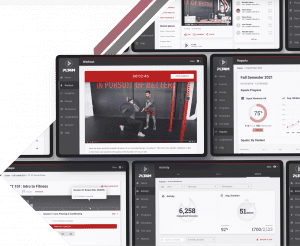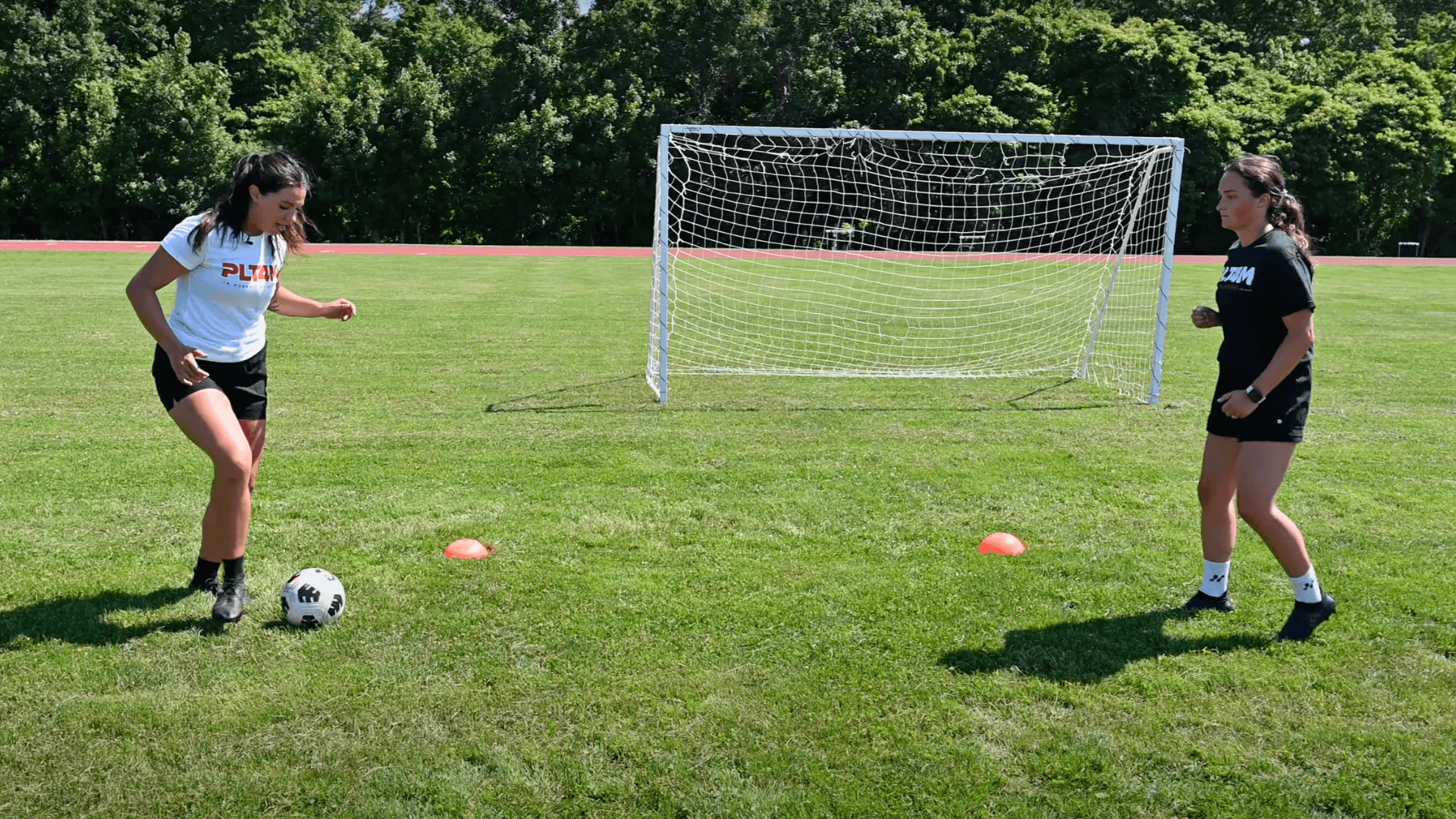The barbell bench press is an excellent movement for students to learn and develop. Whether for athletic development or general fitness, the barbell bench press is one of the most effective exercises for developing muscular strength. But we must prioritize proper barbell bench press form when teaching and incorporating this movement into workouts. This article will explore technique and movement tips for great barbell bench press form.
Benefits of Barbell Bench Press
Upper body pressing is an integral part of any fitness program.
It ensures the proper healthy function of our shoulders and can improve the quality of daily life or athletic endeavors.
While many think of the bench as a simple lift and one only for beach body “bro” pumps, it is actually an excellent place for all individuals to begin developing full-body pressing strength.
And strength is a necessity for all to enjoy a long and healthy life. Strength training increases bone density and staves off osteoporosis, increases caloric expenditure and motivates fat loss, prevents structural ailments like low back pain and knee injury, and all the while helping to stave off chronic disease. But we need to focus on proper barbell bench press form to accomplish all these benefits!

Proper Barbell Bench Press Form Starts With A Strong Foundation
If barbell bench press form is our top priority, then we must consider the foundational elements of the movement pattern. A common fault in middle and high school strength training is jumping right to the barbell. Instead, high school strength and conditioning curriculum should start with bodyweight movement patterns.
A precursor to barbell bench press form is our foundational human movement of the push-up. Our 4 points of performance to the push up are:
Point 1: Hand Placement
Begin by placing your hands, palms down and fingers forward, flat on the ground just outside of the shoulders.
Point 2: Elbow Path
Shoulders should remain externally rotated, aka the upper arms should create and “Arrow”, not a “T” when looked at from above. No elbows flaring out the side!
Point 3: Stable Midline
Core should remain engaged through the lift – like our plank, maintaining a neutral spine. Hips should not sag, or move independent of the torso – think the worm style push up. Hips should never hit the ground and should move in time with the shoulders.
Point 4: Full ROM
The chest must hit the ground/surface at the bottom of every rep, without the thighs doing so. At the top, elbows should be locked out the full extension, without hips sagging.
Real, full-range-of-motion push-ups are HARD. Therefore, we will not start immediately with the full version. Instead, we will learn how to scale the press appropriately. To do so, we will introduce elevated push-ups to modify the difficulty as much or as little as needed for excellent reps.
4 Points of Contact in Barbell Bench Press Form
A key component to barbell bench press form is maintain four points of contact at all times. During the lift you should maintain 4 points of contact:
Butt: There isn’t much to discuss here other than the fact that you need to keep your butt parked on the bench throughout each rep in every set. Your butt will dictate how the rest of your spine will act, and as long as it stays on the bench, you should be just fine. When trying to press heavy weights, individuals will often drive hard with their legs, and the butt will come off the bench. This places a large force on the upper back as it undergoes more flexion. Let’s stay injury free and keep the butt down!
Feet: Believe it or not, your bench press begins with your feet – it all starts with the foundation. Proper foot position is important for generating strength in the movement and ensuring that you execute it safely. Both feet should be in contact with the floor. To start, we suggest both feet are fully flat on the floor, with a 90-degree angle at the knee.
Shoulder Blades: Your shoulder blades should be “retracted” (pulled back) and pressed flat into the bench. Think about pulling the shoulder blades back and down, laying them flat onto the bench. This will put our shoulders into an optimal pressing position.
Head: Firstly, your head should be positioned so your eyes are directly under or just in front of the bar, but not behind. Secondly, the back of your head should always stay in contact with the bench. Often, when weights get heavy and individuals struggle, the head comes off the bench. Finally, to protect your neck, maintain a neutral spinal position by keeping the head flat.
Barbell Bench Press Form – Executing The Lift
Now that we have covered the 4 points of contact for barbell bench press form, let’s prepare to execute the lift. Next up is hand placement.
Basically, we are looking for a symmetrical hand position on the bar that allows for slightly external rotation of the shoulder throughout the range of motion (just like our push ups). We want the elbows tracking back and down, not flaring out to the side. To a degree, exact hand placement will vary slightly between individuals. At the start, we suggest individuals begin by placing their hands on the knurling (rough part of the bar) a “thumbs-distance” from the smooth part.
From here, the execution of any lift is very similar to that of the push up.
We are looking to lower the weight to our sternum by letting the elbows track back and down, never flaring out to the sides. Let’s maintain that “arrow” shape, avoiding the “T” shape or angle with the shoulders and torso. From here we will retrace our steps and press the barbell straight up in the same motion. Push the bar back up in a straight line by pressing yourself into the bench, driving your feet into the floor, and extending the elbows.
Free E-Book!
The Essential Guide to Teaching Weight Training
Our five essential steps to initiate or improve your weight training program. Filled with extra resources, videos, and real-life examples, don’t miss this free resource!
Safety and Failing
Even with good barbell bench press form, there is the potential for a failed rep. The barbell bench press is one of the few lifts in which you should be sure to have an active, attentive spotter for almost ANY set.
You should first set up just off the end of the bench where the individual’s head rests. We recommend angling off the corner, tilted slightly to the side to allow for the recruitment of your legs during any assistance you provide, rather than standing back and away behind the end – requiring a pure hip hinge over the individual and bar.
Then, once you determine the individual is in danger of failing a rep (you can decide the protocols for assistance with your partner, the teacher/coach, etc., before the lift), you step in to provide complete assistance (no finger spotting, here!).
First, drop your hips and grasp the bar inside the individual’s own grip (we recommend an alternating grip with one palm up and one palm down). Now, extend your own hips while shrugging up on the bar into something of an upright row. Use your whole body like a clean pull, don’t try to get a bicep pump!
Once you’ve got the bar off the individual’s chest and to full extension, “walk” it back to the rack. Make sure to hear the bar hit the rack before allowing the bar to drop into the hooks.
Be sure to always have a spotter during anything but the easiest and lightest of weights. And, if you are the spotter, take the job as seriously as you would the actual lift!
Ready to Learn More?
Schedule a free 10 minute consultation to see how the PLT4M system can help save you time, and empower student learning!
Key Takeaways on Barbell Bench Press Form
The barbell bench press is a very popular movement, especially among high school students. Therefore, we take barbell bench press form and spotting seriously!
While we see many individuals (especially high school students) tempted to lift heavy weights, we should only do so with proper barbell bench press form. It can be tempting to cut some corners or lose points of contact or performance to add a few more pounds to the bar. But if we see barbell bench press form suffering at any point, we should take the weight down and make sure form and technique are solid.
Happy Benching!
FAQ
Does PLT4M have other form videos?
Yes, check out our host of other proper form videos including:
Is there a specific age students should start benching?
No, but we want to ensure students have taken part in the proper foundational training before introducing barbells. While the age of this might vary, every student should first build great form and technique in foundational human movements either in middle school pe lessons or high school pe lessons.











